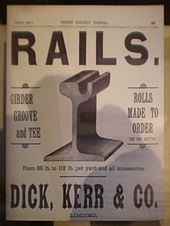 | ||
Dick, Kerr and Company was a locomotive and tramcar manufacturer based in Kilmarnock, Scotland and Preston, England.
Contents
Early history
W.B. Dick and Company was founded in 1854 in Glasgow by William Bruce Dick. The company were initially oil refiners and manufacturers of paint used for coating the bottom of ships. They had depots and works in Glasgow, Liverpool, Newcastle, Barrow-in-Furness, Cardiff and Hamburg by 1890. From 1883 the company joined with John Kerr and under its new name, expanded into tramway equipment and rolling stock and built around fifty locomotives up to 1919.
In 1885 Dick, Kerr and Co started construction of 6 steam launches at its Britannia Works, Kilmarnock. In 1888 it produced the 'Griffin' gas engine which is described and illustrated in The Engineer.
In 1890 it took limited company status, as railway and tramway appliance makers and as iron and steel founders and electricians. There was a public offer of shares to acquire the engineering and contracting company of the same name - reasons given were the advancing years of the senior partner and the need for investment to expand the works at Kilmarnock including a modern iron and steel foundry.
Until the late 1890s the company had largely produced steam tram engines, but soon afterwards it became one of the largest manufacturers of electric tramway cars.
The company facilities in Preston were acquired in 1893 along with the railway and tramway plant activities of Hartley, Arnoux and Fanning who had been bought out by Kerr Stuart and Company.
The company was registered on 24 August 1899, as a reconstruction of a company of the same name, to take over a business of engineers and contractors.
In 1899 the English Electric Manufacturing Co was incorporated as a public company, for purpose of manufacturing, at its own new works at Preston, every variety of electrical machinery, particularly for use by railways and tramways. In 1900 it was an exhibitor at the First International Tramways and Light Railways Exhibition in London.
In 1902 the bulk of the capital of the English Electric Manufacturing Co was acquired, and the capital of that company largely increased, which gave Dick, Kerr and Co a factory at Preston. In the same year, the company was a major exhibitor at the Second International Tramways and Light Railways Exhibition in London.
In 1904 Dick, Kerr and Co were contractors for the Lancashire and Yorkshire Railway's electrification.
From 1904 to 1912, the company supplied first generation tram cars to Hong Kong Tramways. The 60 single deck cars were retired in 1935.
In 1910 they began construction of steam turbines under the Bergmann patents, and one year later built a lamp factory at Preston, to make metal filament lamps.
Dick, Kerr supplied the Municipal Council of Sydney with eleven alternators for its Sydney Electric Lighting Station between 1904 and 1914.
The First World War
During the First World War the company was converted to a munitions factory. The company also made aircraft, to designs from the Seaplane Experimental Station, Felixstowe.
They also produced 100 petrol-electric locomotives for the War Department Light Railways. These locomotives weighed 7 tons and had a 45 hp Dorman 4JO four-cylinder petrol engine driving a 30 kW DC generator at 1000rpm. This supplied current at up to 500volts to 2 traction-motors driving the 32inch wheels via a 6.68:1 reduction gear. The motors had an hourly rating of 25 hp, allowing the locomotive to haul 100tons at 5.2 mph. The two motors were run in parallel, with speed control by altering the generator voltage, and either motor could be cut out in event of a failure. The generator also offered electric starting of the petrol engine by connecting to another locomotive, and the locomotives could also be used as mobile generators. In a parallel order 100 similarly rated locomotives were made by British Westinghouse, who were probably the original designers, though the DC generator/DC motor speed control mechanism is an early example of the application of a Ward Leonard control system (Harry Ward Leonard patented its application to vehicles in 1903). The selection of this drive system was in part because the War Department had originally considered using overhead electric as an alternative way of powering the locomotives, but it was subsequently decided this was not practical.
To improve morale, some of the women employees of this era formed the nationally renowned ladies football team, Dick, Kerr's Ladies.
Dick, Kerr supplied the New South Wales Railways and Tramways (NSWR&T) with 25 cycle alternators for use in Ultimo Power Station and White Bay Power Station, which were commissioned from 1913 to 1918.
In 1917 they acquired the United Electric Car Company of Preston.
Post war
In 1919 the Kilmarnock works were sold to the Kilmarnock Engineering Company, and the company was taken over by English Electric. In 1968 English Electric merged with GEC.
Surviving locomotives
Dick Kerr locomotives known to have survived:
